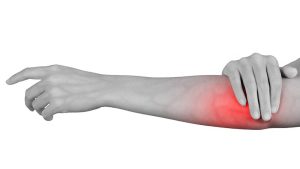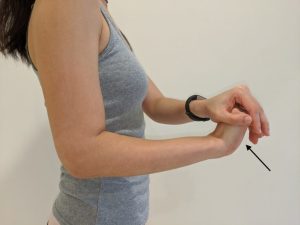Tennis Elbow, known to health professionals as Lateral Epicondylitis, is an overuse injury to the area. The location of this is on the outside of your elbow where the tendons of your forearm muscles attach to the bone. It happens when repetitive stress or load is put on the area causing inflammation, or microscopic tears, in the tendon. The muscles involved with this area are responsible for wrist and finger extension, as well as to stabilise the wrist when gripping objects.

As the name suggests, Tennis Elbow commonly occurs in tennis players. This is because the forearm is under high amounts of stress when the racket is making contact with the ball. But it can also occur from other tasks such as lifting weights, working with tools or typing at the computer. There are even some cases where Tennis Elbow occurs spontaneously without a specific cause.
How do I know if it is the cause of my pain?
Symptoms include:
- Aching pain or burning sensation on the outside of your elbow, sometimes spreading into the forearm or upper arm
- Grip strength becomes weaker/ painful
- Pain can be worse when doing tasks involving movement or lifting with the elbow or wrist
- Aching can be worse at night
There are other conditions that can feel similar to tennis elbow so it is always beneficial to see your physiotherapist for a more comprehensive exam.
How do I get better?
Lateral Epicondylitis can usually improve significantly with 8-12 weeks of treatment, but patience is essential as sometimes full recovery can take 6-12 months.
Avoiding or modifying the activity that aggravates symptoms is the first step.
Another effective way to improve the condition is a structured exercise program to slowly ease pain and restore function. Read on for examples of some stretches and an exercise that you can start anytime and do everyday. There are many more but it’s best to progress with the guidance of a physiotherapist to optimise a full recovery and prevent a reoccurrence.
- Wrist Flexion and Extension stretches
With your elbow straight, use the non-affected hand to gently stretch the wrist of your painful side as shown in the photos. One stretch is with the palm facing away from you and the other is with the palm facing towards you. Slight pain may occur with this stretch but don’t push into severe pain. Hold for 20 to 30 seconds x 3 sets.


- Isometric Wrist Extension
Try to bend the wrist of the painful side upwards while resisting at the top of the knuckles with the non-affected hand. There should not be movement and you may feel some pain in the forearm/elbow. Press only as hard as you are comfortable and pain should not exceed 4/10. Hold this contraction for 45 seconds x 5 sets with a 1 min break in between.

In addition to exercises, your physiotherapist will also use manual techniques like joint mobilisation and massage to reduce symptoms and improve function. They may also use dry needling, taping, braces, and electrophysical equipment to provide physiological and therapeutic benefits.
You can receive personalised treatment form one of our expert physiotherapists by BOOKING ONLINE, today! Alternatively, you can call us on 9267 3775.

